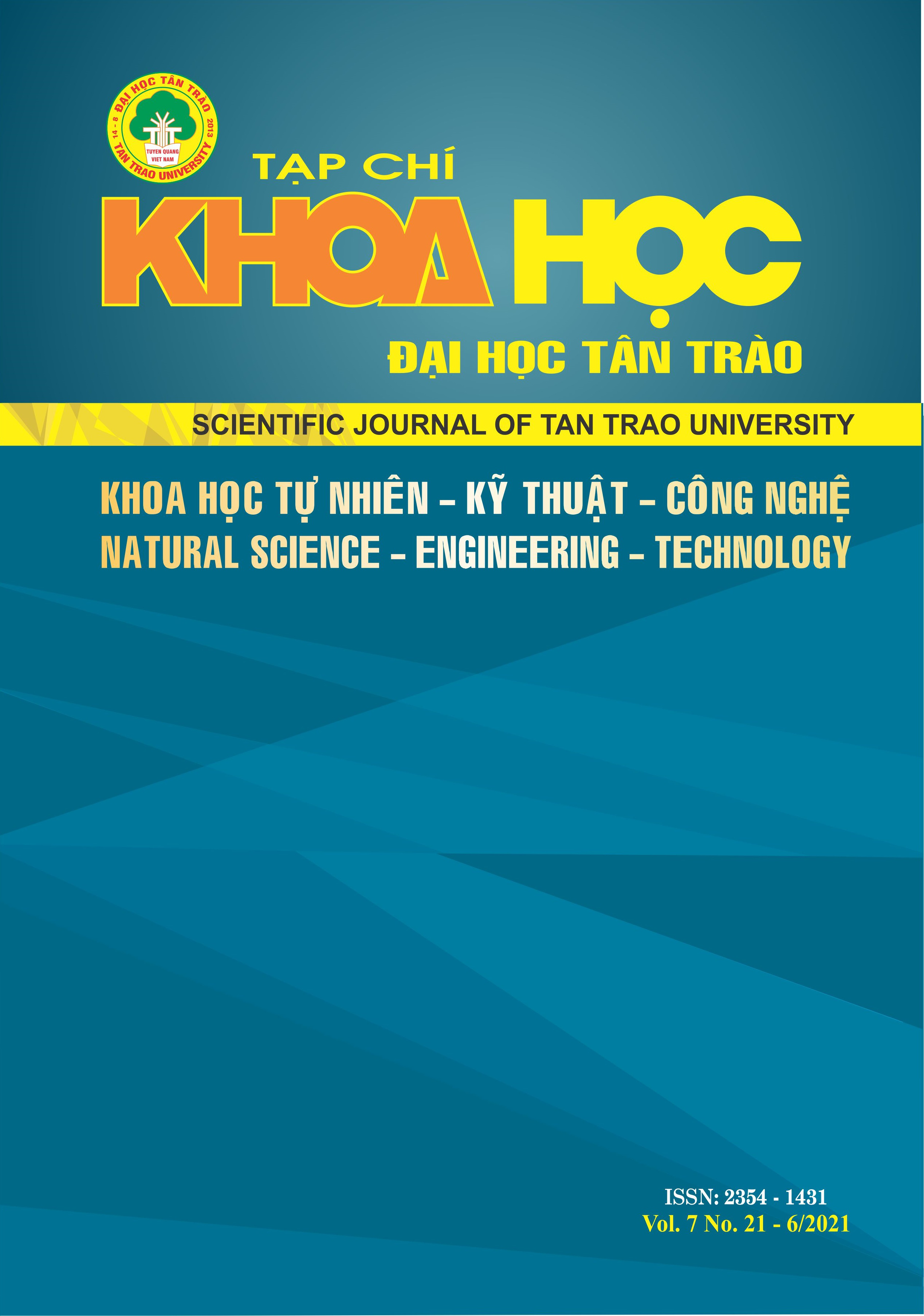SYNTHESIS OF WO3 NANORODS BY HYDROTHERMAL METHOD FOR CO GAS SENSOR APPLICATIONS
DOI:
https://doi.org/10.51453/2354-1431/2021/460Keywords:
Cảm biến khÃ, thanh nano WO3, thuá»· nhiệtAbstract
WO3 nanorods were synthesized through a simple, low-cost hydrothermal method using a soft template, followed by calcination. The morphology and crystal structure of the WO3 nanorods were examined by field emission scanning electron microscopy (FE-SEM) and X-ray diffraction (XRD). The gas sensors are fabricated by drop-casting and test for CO toxic gas at different temperatures in the concentration range from 100 ppm to 1000 ppm. The best performance was found at the working temperature of 400oC with the highest response of 2.7 to 1000 ppm CO. The sensor showed fast response/recovery time (7 s/11 s), and good stability after six consecutive measurement cycles. In addition, sensor selectivity has also been studied for CO, NH3, CO2, and CH4.
Downloads
References
[1] Tsujita, W., Yoshino, A., Ishida, H., Moriizumi T. (2005) Gas sensor network for air-pollution monitoring. Sensors Actuators, B Chem., 110: 304–311.
[2] Kim, H., Jin, C., Park, S., Kim, S., Lee C. (2012). Chemical H2S gas sensing properties of bare and Pd-functionalized CuO nanorods. Sensors Actuators B. Chem., 161: 594–599.
[3] Lee, I., Choi, S.J., Park, K.M., Lee, S.S., Choi, S., Kim, D., Park, C.O. (2014) The stability, sensitivity and response transients of ZnO, SnO2 and WO3 sensors under acetone, toluene and H2S environments. Sensors Actuators, B Chem., 197: 300–307.
[4] Stewart, M.J. (1994). Laboratory Investigation of the Poisoned Patient. (1994) Scientific Foundations of Biochemistry in Clinical Practice, 736–757.
[5] Mahajan, S., Jagtap, S. (2020) Metal-oxide semiconductors for carbon monoxide (CO) gas sensing: A review. Appl. Mater. Today, 18, 100483.
[6] Huang, K., Pan, Q., Yang, F., Ni, S., Wei, X., He, D. (2008). Controllable synthesis of hexagonal WO3 nanostructures and their application in lithium batteries., J. Phys. D. Appl. Phys. 41, 2001.
[7] Gao, X., Su, X., Yang, C., Xiao, F., Wang, J., Cao, X., Wang, S., Zhang L. (2013). Hydrothermal synthesis of WO3 nanoplates as highly sensitive cyclohexene sensor and high-efficiency MB photocatalyst. Sensors Actuators, B Chem. 181: 537–543.
[8] Yang, A., Wang, D., Lan, T., Chu, J., Li, W., Pan, J., Liu, Z., Wang, X., Rong, M. (2019). Single ultrathin WO3 nanowire as a superior gas sensor for SO2 and H2S: Selective adsorption and distinct I-V response .Mater. Chem. Phys. 240, 22165.
[9] An, S., Park, S., Ko, H., Lee, C. (2013) Fabrication of WO3 nanotube sensors and their gas sensing properties. Ceram. Int. 40: 1423–1429.
[10] Jia, J., Liu, X.D., Li, X., Cao, L., Zhang, M., Wua, B., Zhou, X. (2020) Effect of residual ions of hydrothermal precursors on the thickness and capacitive properties of WO3 nanoplates. J. Alloys Compd. 823, 153715.
[11] Xu, H., Gao, J., Li, M., Zhao, Y., Zhang, M., Zhao, T., Wang, L., Jiang, W., Zhu, G., Qian, X., Fan, Y., Yang, J., W. Luo, W. (2019). Mesoporous WO3 Nanofibers With Crystalline Framework for High-Performance Acetone Sensing. Front. Chem. 7, 266.
[12] Tong, P.V., Hoa, N.D., Duy, N.V, Hieu, N.V. (2015). Micro-wheels composed of self-assembled tungsten oxide nanorods for highly sensitive detection of low level toxic chlorine gas. RSC Adv. 5: 25204–25207, Vietnam.
[13] Sharma, S., Madou, M. (2012). A new approach to gas sensing with nanotechnology. Philos. Trans. R. Soc. A Math. Phys. Eng. Sci. 370: 2448–2473.
[14] Khai, T.V., Thu, L.V., Ha, L.T.T., Thanh, V.M., Lam, T.D. (2018) Structural, optical and gas sensing properties of vertically well-aligned ZnO nanowires grown on graphene/Si substrate by thermal evaporation method. Mater. Charact. 141: 296–317, Vietnam.
[15] Hübner, M., Simion, C.E., Haensch, A., Barsan, N., Weimar, U. (2010). CO sensing mechanism with WO3 based gas sensors. Sensors Actuators B Chem. 151: 103–106.
Downloads
Published
How to Cite
Issue
Section
License

This work is licensed under a Creative Commons Attribution-ShareAlike 4.0 International License.
All articles published in SJTTU are licensed under a Creative Commons Attribution-ShareAlike 4.0 International (CC BY-SA) license. This means anyone is free to copy, transform, or redistribute articles for any lawful purpose in any medium, provided they give appropriate attribution to the original author(s) and SJTTU, link to the license, indicate if changes were made, and redistribute any derivative work under the same license.
Copyright on articles is retained by the respective author(s), without restrictions. A non-exclusive license is granted to SJTTU to publish the article and identify itself as its original publisher, along with the commercial right to include the article in a hardcopy issue for sale to libraries and individuals.
Although the conditions of the CC BY-SA license don't apply to authors (as the copyright holder of your article, you have no restrictions on your rights), by submitting to SJTTU, authors recognize the rights of readers, and must grant any third party the right to use their article to the extent provided by the license.


